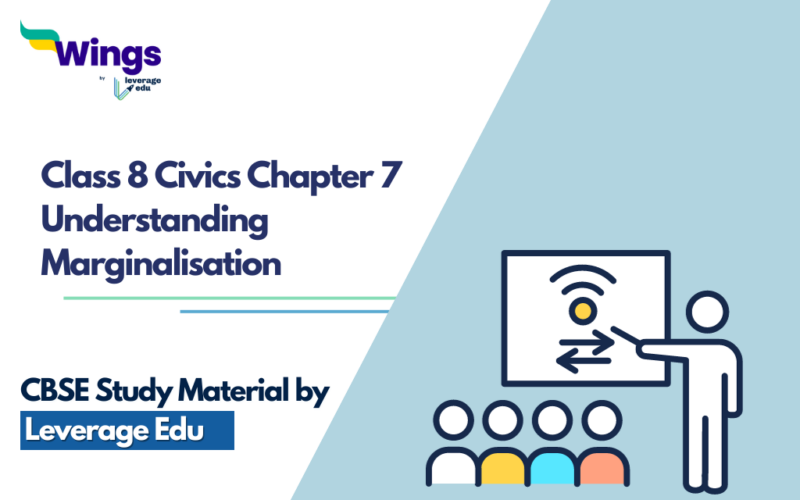Marginalisation corresponds to a long history of certain minority communities struggling for equality. However, understanding what marginalisation means and how certain communities are referred to as marginalised is a complicated concept. Class 8 SST syllabus includes a chapter on ‘Understanding Marginalisation’ which aims to familiarise students with concepts like Adivasis, Minorites, and Muslims, and safeguards methods to protect and develop them. This blog brings you the revision notes on Understanding Marginalisation as well as questions and answers.
Download Social Science Class 8 Civics Chapter 7 Important Questions and Answers PDF
Important Short Notes in NCERT Class 8 Chapter 7
What is Marginalisation?
‘Marginalised’ as a term refers to those individuals or groups of persons in the social environment who are treated as less important or fall under the category of lower sections in society. As per Class 8 Understanding Marginalisation, ‘Socially Marginalised’ are those who are marginalised on the basis of if they speak a different language, follow different customs, belong to a different religious group from the majority community are not accepted by society.
In other words, ‘Marginalised’ means to be forced to occupy the sides or fringes and hence not be at the centre of things.
- Socially excluded people are viewed with hostility and fear.
- There is a sense of difference between different communities.
- There are also social, economic and political factors where certain groups are marginalised.
Also Read: Mineral and Power Resources Class 8
Who are Adivasis?
The term originally refers to inhabitants – communities who lived and often continue to live, in close association with forests. 8% of the Indian population are Adivasis. As per the Class 8 chapter on Understanding Marginalisation, there are around 500 different groups of Adivasis in India. They are not among a homogeneous population.
- Most of the Industrial and mining areas of India are located in the Adivasis area.
- Orissa is for more than 60 different tribal groups. Also, they are found in states like Gujarat, Maharashtra, Rajasthan, Andhra Pradesh, and West Bengal, and in the north-eastern states of Arunachal Pradesh, Assam, Manipur, Meghalaya, Mizoram, Nagaland, and Tripura.
- They have a different range of tribal religions like Shakta, Buddhism, Vaishnav, Bhakti, and Christianity, other than Islam or Hinduism.
- Adivasis have their own languages, which are as old as Sanskrit. Santhali was spoken by a large number of people and had a huge publication.

Must Read: Law And Social Justice Class 8
Adivasis and Stereotype
Stereotype as a characteristic has been imposed upon groups of people on the basis of race, sexuality, nationality, or orientation. You will learn more about how Adivasis are stereotyped in Class 8 Understanding Marginalisation, here is a summary of this section:
- Adivasis are wrongly portrayed in ways like colourful costumes, headgear, and their dancing skills.
- Blamed for their lack of advancement in society.
- They are also believed to be exotic, primitive, and backward.
Adivasis and Development
Forests play a crucial part in the development of various areas in India. For example, metal ores, medicinal herbs, diamonds, animal products like wax or honey, coal, etc have all come from the forests. Adivasis are commonly the tribal communities that live near forests and rely on them for their livelihood. Here are the important pointers you must remember while understanding marginalisation from the perspective of Adivasis and development:
- The life of people is heavily dependent on forests which plays an important role in providing the availability of a clearer quality of air and water.
- Till the 19th century, Adivasis had all access to these vast tracts.
- All the empires were majorly dependent on forest resources.
- They were once known as hunter-gatherers and nomads in the pre-colonial period.
- They lived by shifting agriculture and cultivating in one place.
- For the past two hundred years, Adivasis have been forced through economic changes, forest policies, and political force applied by the State to migrate as workers in plantations, industries, and as domestic workers.
Minorities and Marginalisation
The term minority refers to those communities that are numerically small in relation to the rest of the population. Let’s take a look at the features of Minority as elaborated in Class 8 Understanding Marginalisation:
- It confines the issues of power, and access to resources and has social and cultural dimensions.
- Safeguards are required in order to protect minority communities against the possibility of being culturally overpowered by the majority. They also protect them against any discrimination or harm they may face.
- The Constitution provides these safeguards so that India remains culturally diverse and promotes equality as well as justice.
Muslims and Marginalisation
13% of the Muslim community is marginalised in India. They have over the years been deprived of the benefits of socio-economic development, basic amenities, literacy, and public employment. Take a look at the revision pointers in this section under Class 8 Understanding Marginalisation:
- Muslim customs and practices such as wearing the burqa and fez make them different from others and this is why they tend to be identified differently and are not like the rest of the Muslims.
- These socially excluded Muslims in some instances have led to their migration from places where they have lived which leads to the ghettoization of the community.
- Ghettoization: A ghetto is an area or locality that is largely populated by people of a particular community. This can be due to various social, cultural, and economic reasons.
Important Questions and Answers in NCERT Class 8 Chapter 7 Understanding Marginalisation
Q.1 Explain marginalisation in two or more sentences.
Individuals or groups of persons who are socially excluded. Individuals or groups of persons who are considered untouchables by majority communities.
Q.2 State two reasons why Adivasis are becoming increasingly marginalized.
Adivasis are not considered a homogeneous population. Adivasis are blamed for the lack of advancement in society. They are also marginalised on the factors like social, economic, and political.
Q.3 List one reason – why you think the Constitution’s safeguards to protect minority communities are very important.
Safeguards are required to protect minority communities against the possibility of being culturally dominated by the majority. They also protect them against any discrimination and disadvantage that they may face. The Constitution provides these safeguards because it is committed to protecting India’s cultural diversity and promoting equality as well as justice.
Q.4 Re-read the section on Minorities and Marginalisation. What do you understand by the term minority?
The term minority refers to communities that are numerically small in relation to the rest of the population.
Q.5 You are participating in a debate where you have to provide reasons to support the following statement: ‘Muslims are a marginalized community. Using the data provided in this chapter, list two reasons that you would give.
13% of the Muslim community is marginalised in India. (a) They have over the years been deprived of the benefits of socio-economic development, basic amenities, literacy, and public employment. (b) Muslim customs and practices such as wearing the burqa and fez make them different from others and that is why they tend to be identified differently and are not like the rest of the Muslims. This often becomes an excuse to treat them unfairly. This social marginalization of Muslims in some instances has led to their migration from places where they have lived, often leading to the ghettoization of the community.
Q.6 Imagine that you are watching the Republic Day parade on TV with a friend and she remarks, “Look at these tribals. They look so exotic. And they seem to be dancing all the time”. List three things that you would tell her about the lives of Adivasis in India.
Two reasons to support the statement that Muslims are a marginalised community are:
The literacy rate is 57% of the Muslim population which is the lowest compared to 63% among Hindus, 67% among Sikhs, 71% among Buddhists, 74% among Christians, and 86% among Jains. For example, according to the data, only 63.8% of Muslims could get access to electricity in comparison to 65.4% among Hindus, 69.3% among Christians and 91.3% among Sikhs.
Q.7 Economic marginalization and social marginalization are interlinked. Do you agree? Why?
Yes, marginalised as a term refers to individuals or groups of people who are socially excluded on the basis of race, nationality, orientation, etc. They are not able to avail basic amenities such as healthcare, education, or jobs which creates economic disbalance. Hence, it leads to no economic development for the minorities, so they remain backward and considered socially marginalised.
Check out Notes Class 7 Civics
FAQs
Individuals or groups of persons who are socially excluded. Individuals or groups of persons who are considered untouchables by majority communities.
Adivasis are not considered a homogeneous population. Adivasis are blamed for the lack of advancement in society. They are also marginalised on the factors like social, economic, and political.
Yes, marginalised as a term refers to individuals or groups of people who are socially excluded on the basis of race, nationality, orientation, etc. They are not able to avail basic amenities such as healthcare, education, or jobs which creates economic disbalance. Hence, it leads to no economic development for the minorities, so they remain backward and considered socially marginalised.
Follow Leverage Edu for complete study material on CBSE Notes of Class 8 Civics

 One app for all your study abroad needs
One app for all your study abroad needs
























 45,000+ students trusted us with their dreams. Take the first step today!
45,000+ students trusted us with their dreams. Take the first step today!


